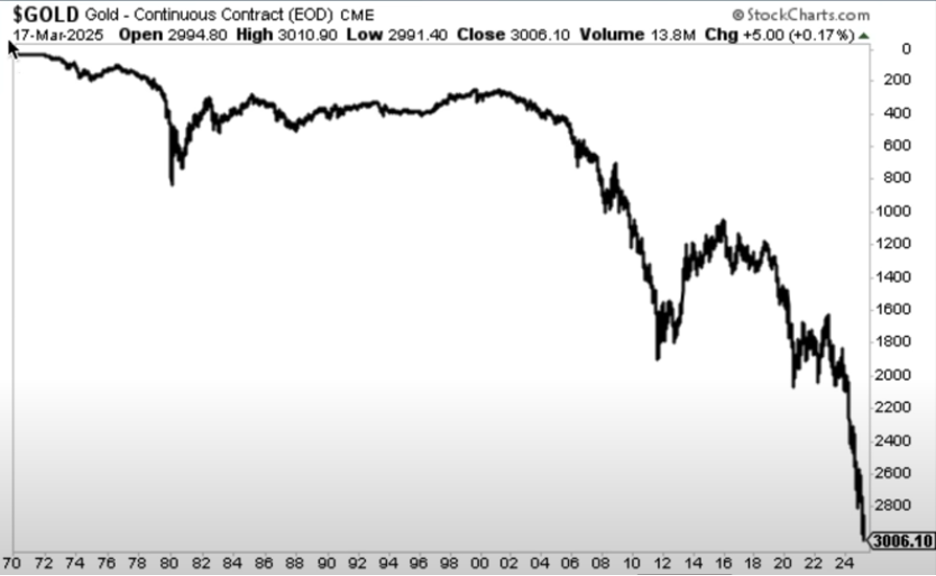Constitutional Money: Who Killed It, What Follows?
Below, we conduct a necessary autopsy on the death of Constitutional money.
The Constitution Matters
Most of us, myself included, have a favorite lawyer joke (or two), but law school had its shining moments, including our deep dive into the US Constitution.
Written (and signed) by admittedly flawed men, the founding fathers of the United States were many things, but they were not altogether stupid.
Countless books have been written about the Constitution’s 18th century authors, signers and, of course, meaning, interpretation, use and power.
No single article here can ever address or answer the scope of debate which such Constitutional themes have inspired from day 1.
Protecting the Governed
What is beyond debate, however, was that, like the 1776 Declaration of Independence, the subsequent Constitution of 1789 was drafted with a clear and guiding premise: To protect the governed from the governing.
Or stated more simply, the founding fathers shared a deep distrust for, and disdain of, predatory government.
Why?
Because the United States was born from a distrust of government in general and human nature in particular – and not just that of the Mad King George III.
Stated more simply: This seminal document was designed to protect its citizens from autocracy and human nature.
No Easy Task
And this premise–no easy task then or now–was meant as a written and legal directive, not as a suggestion.
The founders understood that human nature, as well as human courts and politicians, have an immense talent for bending the law to meet personal, financial and political biases.
“The politics of the legal system” and Constitution are admittedly complex, as I learned even as an under-grad through the guidance of legends like Ted Beiser.
A History of Debates, Paradoxes & Creative Bending
The Constitution, for example, which lauded freedom and liberty as a primary value, was drafted by men who owned slaves and denied such concepts to others – a denial which subsequent Supreme Court interpretations supported with clever words behind darker motives – from Dred Scott v. Sanford (1857) to Plessy vs. Ferguson (1896).
In fact, it would take a 19th-century civil war (and then some) to begin righting such “interpretations” of freedom, equality, and even man vs “property.”
Words, again, can be bent, which means the spirit and even intent of the laws can be bent.
And then there’s the ongoing and deeply divisive example of the pro-life vs. pro-choice debate.
The same Constitution which protects “life” (fetus) also protects “liberty” (mother) – and today’s headlines confirm that balancing and debating such values can be highly polarizing and subject to very personal interpretation – in the court as well as on the streets.
Getting Back to Money & Metals
But what does any of this have to do with money, gold or the slow-drip decline of Constitutional money and your financial future?
Actually, a heck of a lot.
Money Was Never Up for Debate
Unlike so many debatable and “bendable” interpretations of the letter and/or spirit (and math) of the Constitution (from the Commerce Clause to the 8th or 14th Amendments), the founding fathers’ spirit, letter and intent when it came to “money” was uniquely clear and unequivocal.
Art 1, Sections 8 and 10 of the Constitution tell us in no uncertain terms that our nation’s money was meant to be measured in gold and silver.
Period.
Why?
Because these flawed yet farsighted founders understood that if our money was not chaperoned by a precious metal, leaders would eventually be seduced toward expanding and thus debasing that money to subsidize the nation’s debts and increase their powers.
Such temptations, they knew then (and as some of us still know today), would lead to the nation’s eventual destruction from within and a subsequent rise of tyranny, and again, the one evil the founding fathers feared most.
History Matters
They understood this because they understood history – from the fall of ancient Rome and the John Law era of 1720 to the then-occurring collapse of the French currency and empire in Paris, all of which I’ve addressed extensively here: French Lessons.
In short: History, and the framers of the Constitution, warned us that debt destroys nations.
As I have also said countless times, debt leads to inflation and, hence, social unrest, which all debt-strapped regimes, without historical exception, try to then postpone via currency debasement, more centralized controls and war.
Sound and look familiar today?

How We Lost Our Way
But if such fundamental concerns, principles and history lessons were the very bedrocks of the Constitution’s clear understanding of money, how did the US get to the current and frankly anti-Constitutional (and increasingly worthless) paper money system of today?
The answer is simple.
Debt & Desperation (Civil War)
Like desperate people, desperate governments do desperate things, regardless of their alleged values, ideals or even the Constitution itself.
In the case of the relatively short history of the US, the first cracks in our Constitutional/money armor arrived during the all too desperate period of the US Civil War (1861-1865).
Wars, after all, are expensive, and when the gold ran out, DC, under the duress of military necessity, decided to issue Greenbacks—i.e. paper money—to pay down debt.
Was this “constitutional”?
On its face, not at all.
But the always-clever Supreme Court, in what was then known as the “Legal Tender Cases”, argued that those inflated Greenbacks would be temporarily allowed so long as: 1) paper money was not seen as legal tender or a store of value and 2) that the government would eventually repay those Greenbacks back in gold.
Slow Drip Toward Stupid
After the Civil War, the Resumption Act, which “resumed” a gold-backed US monetary system, was passed, and that same Supreme Court was then tasked with once again addressing the Constitution’s otherwise clear guidance as to gold and silver as money.
But what did the Supreme Court do?
Actually, they began to slowly back away from the otherwise clear gold and silver guidance offered by the Constitution.
The court then declared that DC could issue Greenbacks with or without a war excuse.
The court consoled the trusting yet monetarily un-savvy masses with the declaration that such debates were just academic anyway, as gold-backed money had returned after the war.
But not for very long…
FDR’s Confiscation
Enter FDR and the New Deal era of 1933 gold confiscation and dollar revaluation…
This was followed by the ever-so political (and politically packed) Supreme Court, which was once again tasked with interpreting (i.e., denunciating) the Constitution (and our money) for us…
In the now forgotten but then infamous “Gold Clause Cases,” the court was specifically addressing what was a very important matter to US bondholders, all of whom expected that at least their bonds be repaid at gold parity even if their currency was not.
The Supreme Court’s answer?
No need for such gold parity, as the USD in 1933 was safe enough and as valuable as silver, so who needs any such gold clauses or guarantees?
That, of course, was just, well… a lie.
Nixon’s Fatal Blow
But in case anyone still held any post-Bretton Woods illusions at all about the slow, frog-boil death of Constitutional money in the US, Nixon ended the suspense once and for all in 1971 when he officially decoupled the USD from its Constitutionally directed gold chaperone.
Like the Supreme Court of the Civil War era (or Powell of the current inflationary era), Nixon famously declared that such a de-coupling would only be “temporary.”
He also promised that the dollar of 1971 would be worth just as much after decoupling from gold as it was before.
Both of these fine statements, of course, were just, well… lies.
Today: Total Fiasco
Now, some 54 years since Nixon’s lie, the US currency remains de-coupled from its Constitutionally mandated gold chaperone (hardly “temporary”), and when measured against a milligram of gold, that paper USD has lost 99.3% of its purchasing power in the same time period.
Thus, if you’re still wondering why the gold price is going up…

…all you have to do is inverse the image above, which eerily resembles the chart below for how the value of the USD is (and has been) going down:

No Surprise…
The fall of such paper money should be of zero surprise to ANYONE in 2025 for the simple reason that it was of no surprise to the Constitution’s founding fathers in 1789.
They literally warned us THEN of our own crisis TODAY.
By ignoring, bending and hiding such warnings in the many decades since, the net result is that the very country this Constitution sought to protect from debt, tyranny, desperation, centralized controls, unnecessary wars and currency destruction now finds itself in a blender of each of the foregoing.
Death by Suicide
But as even John Adams confessed from the birth of the US and its Constitution, “there never was a democracy yet that did not commit suicide.”
In this tragic-comical manner, sound money eventually died.
And as shown above, it did so slowly, over time, in a death by 1000 legal and political cuts, a foreseeable crime which occurred right beneath our blind eyes and smiling leaders.
The Post-Mortem…
Today, the ripple effects of Constitutional money’s death and the fatal debt levels which thus followed are literally all around us.
Pull on any thread of any headline, and it all comes back to the destructive debt levels which only paper money can spawn.
Today, the US desperately seeks to cut agency debt levels (DOGE), valiantly reveal wasteful spending (USAID), downplay (or tariff) otherwise obvious de-dollarization shifts among the BRICS+, refill its empty COMEX, speculate with a politically comical yet inflated BTC Reserve miracle and flirt with Hemingway’s war warnings from Iran and Yemen to the South China Sea while its economically broke and divided citizens become increasingly centralized.
Why?
Because the US is rotting from unsustainable debt and the unloved, weaponized and debased paper dollar, it corrupted – along with the Constitution – years and years ago to pay those debts.
But if, instead, we had stuck to the letter, spirit and intent of the very Constitution that defined our money in gold and silver, such debt would have never gotten this far, and the fall of our nation and dollar would have never gotten this low.
Ladies and gentlemen, the Constitution kinda matters, but the very folks who pledge allegiance to it at every swearing-in ceremony today have likely never read it, and their predecessors killed it.
So, if your leaders and courts won’t protect your “money” with gold, perhaps you should do it for yourself?
About Matthew Piepenburg
Matthew Piepenburg
Partner
VON GREYERZ AG
Zurich, Switzerland
Phone: +41 44 213 62 45
VON GREYERZ AG global client base strategically stores an important part of their wealth in Switzerland in physical gold and silver outside the banking system. VON GREYERZ is pleased to deliver a unique and exceptional service to our highly esteemed wealth preservation clientele in over 90 countries.
VONGREYERZ.gold
Contact Us
Articles may be republished if full credits are given with a link to VONGREYERZ.GOLD




